Assets & Packages
Assets and packages is how you protect and sell your digital content.
Package management
Our platform offers the ability to combine multiple assets into a bundle, which can then be sold under one price.
We call these bundles packages.
Once the viewer purchases a package, they will automatically have access to all assets that have been placed in that package.
Note that packages themselves are not embedded on a webpage.
The asset is still the thing you need to embed on your page because that is where the actual content is located.
The package only serves to bundle multiple assets under a single price.
When a viewer clicks on an asset that is a part of a package, the package price will appear in the asset’s price options, and by selecting it, the viewer will get access to all assets that are part of the package they’ve just purchased.
To access the assets, the viewer will need to navigate to the place on your website where the assets have been embedded.
Creating a Package
Log into your InPlayer Dashboard, go to the Content section, and then to the Packages tab.
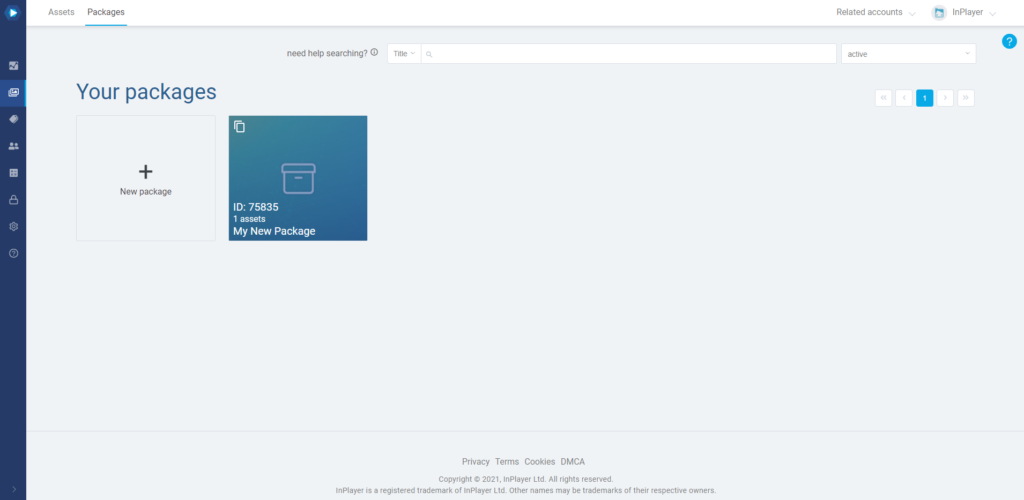
Click on New package.
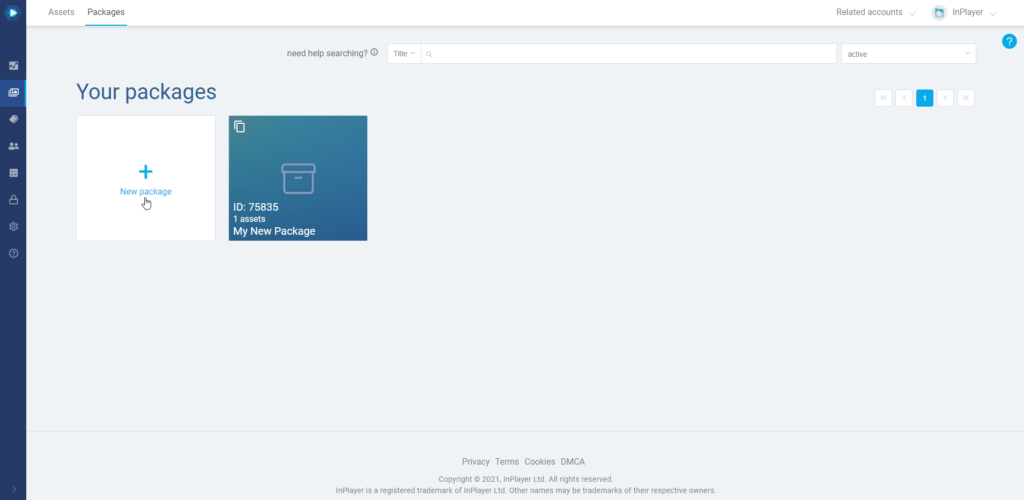
Enter a name for your package. This will appear on the final payment form on the paywall, as well as the notification emails your viewers will receive.
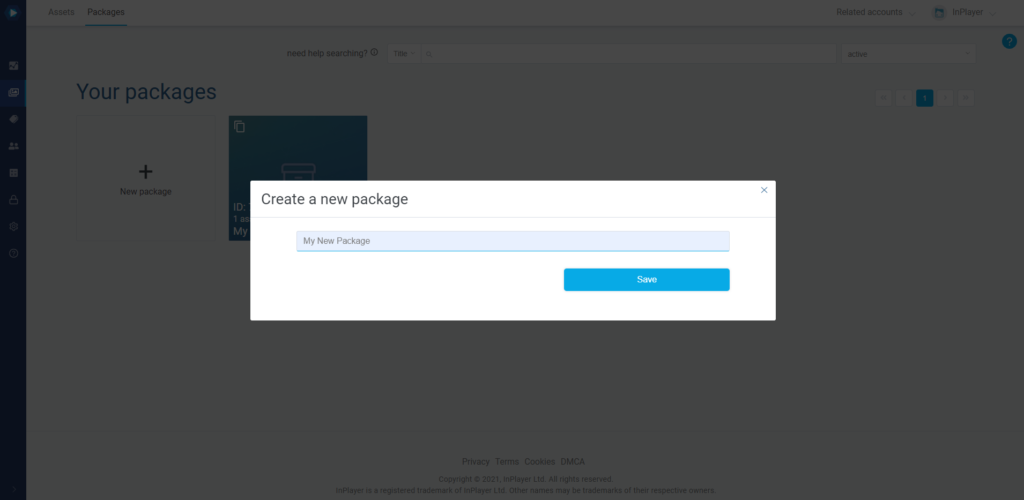
Click Save.
Your package is now created and saved.
On the new page, you can set up the package properties.
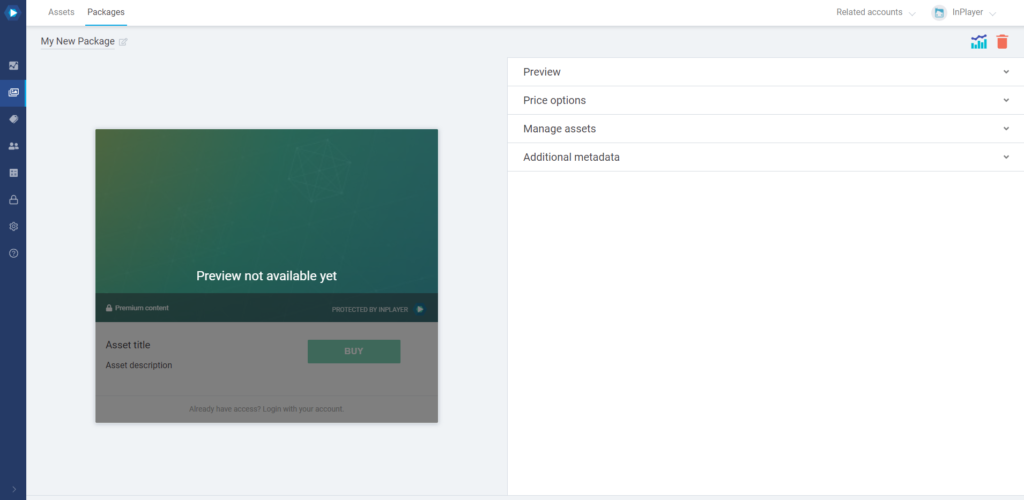
Just like in the asset section, the right side of the screen is where you can set everything up, and the left side provides a preview. However, since the package itself will not be embedded on your webpage, the preview is more for your own convenience.
Preview
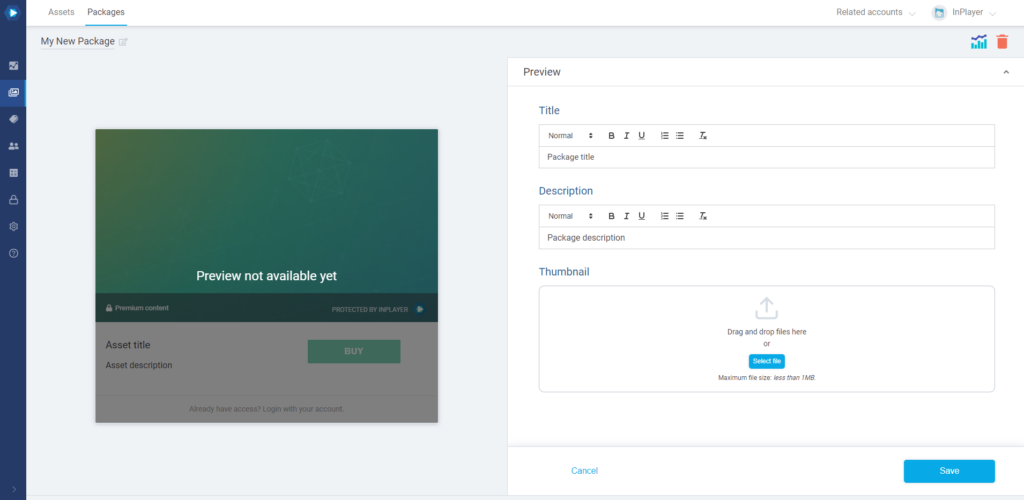
In the Preview section, you can set up the title, description, and thumbnail. Note that the Title, Description and Thumbnail will not appear anywhere on your webpage. They are more for your own use for easier package management.e package Title however, will appear on the final payment form on the paywall, as well as the notification email your viewers will receive.
After setting everything up, make sure to click the Save button in the bottom right corner.
Price options
You can set up three different pricing types:
- ppv – the viewer makes a one-time payment and gets access for a limited time,
- subscription – the viewer accepts a recurrent charge at regular intervals that can be canceled at any time,
- season – the viewer makes a payment and gets access for a limited period, but at the same time accepts a recurrent charge for being able to watch during the next period. The date for the upcoming charge is determined by the merchant.
Note that the season price type needs to be activated on your account by our team, so make sure to contact us at clients@inplayer.com for this.
Setting up a PPV price
In the Price options section, click New price.
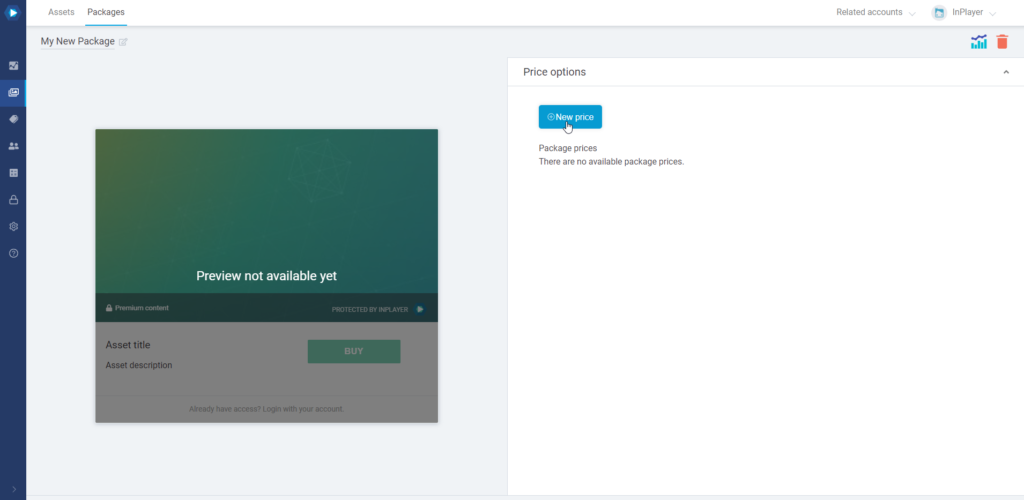
In the General info tab of the price option, set up the following:
- In the Price description field, enter the price description that will appear on the paywall. Make it concise so your viewers know exactly what they are buying.
- In the Payment type field, select ppv.
This is a one-time payment which grants access that expires after the end of the specified period counter either from the moment of purchase, or if using the Schedule start feature, from the date set in the Schedule start field (more on this below).
The access period can be selected from the drop-down menu.
You can pick one of the available periods, or use the custom period option.
When using the custom period option, you can specify the exact date and time at which the viewers’ access will expire. This is very useful for doing presales since the viewers’ access will expire on the date you’ve set up, regardless of when they’ve purchased their pass. An alternative way to set up presales is by using the Schedule start option from the Additional info tab. More on that below. - In the Amount field, enter the price.
The minimum price when using USD, EUR, or GBP is 1. When using all other currencies, the minimum is the equivalent converted amount of 1 USD.
The currency can be selected from the drop-down menu. If you wish to use a currency that is not on the list, you can contact us at clients@inplayer.com and we’ll make sure to add the currency for you asap. We support all currencies listed here.
In the Additional info tab, you can set up the following:
- Schedule start
This is the date and time at which the viewer’s access period will start after they’ve purchased the asset. Until that time, they will see a message informing them to come back on the scheduled date.
This is a useful option for setting up presales. You can select the access period from the Payment type section in the General info tab, and then set up when will that access period begin. It works for both the pre-defined access periods (24 hours, 48 hours, etc), and for the custom period.
If you leave the Schedule start field blank, the viewers’ access will begin right after purchasing.
Note that if you change the scheduled start setting after some viewers have made their purchase, their access start will not change.
Always set this according to your own timezone. This will be automatically converted to the viewer’s own timezone, based on the time settings of their device’s operating system. Their IP address location does not play a role here. - Geo-restriction
With this option, you can restrict the price option to specific countries.
You can choose to either allow (whitelist) or deny (blacklist) a single country, or use a country set you have created previously.
You can learn more about setting up country sets here.
After setting everything up, make sure to click the Save button in the bottom right corner.
Note that once you set the payment type for an asset, you cannot change it. You can change the other payment fields (access period duration, price, etc) but not the payment type. If you wish to set a new payment type, you will need to set up a new price option.
If you’d like to have a custom ppv access period added to the list of pre-made periods under Payment type, you can reach out to your account manager or our support team at clients@inplayer.com.
Setting up a Subscription price
In the Price options section, click New price.

In the General info tab of the price option, set up the following:
- In the Price description field, enter the price description that will appear on the paywall. Make it concise so your viewers know exactly what they are buying.
- In the Payment type field, select subscription.
This is a recurring payment that is renewed automatically. Access is granted at each renewal.
The renewal period can be selected from the drop-down menu. - In the Amount field, enter the price.
The minimum price when using USD, EUR, or GBP is 1. When using all other currencies, the minimum is the equivalent converted amount of 1 USD.
The currency can be selected from the drop-down menu. If you wish to use a currency that is not on the list, you can contact us at clients@inplayer.com and we’ll make sure to add the currency for you asap. We support all currencies listed here.
In the Additional info tab, you can set up the following:
- Free trial
With this, you can set up a free trial period. Free trials are tied to a viewer’s credit card, and not their account. If they open a second account but still use the same card to buy their second subscription, they will not get a second free trial. This is intended to prevent abuse. - Additional fee
With this option, you can set up a one-time fee that will be charged when the viewer purchases the subscription, as an addition to the regular subscription fee. The fee will only be charged once, together with the first subscription charge. - Geo-restriction
With this option, you can restrict the price option to specific countries.
You can choose to either include (whitelist) or exclude (blacklist) a single country, or use a country set you have created previously.
You can learn more about setting up country sets here.
After setting everything up, make sure to click the Save button in the bottom right corner.
Note that once you set the payment type for an asset, you cannot change it. You can change the other payment fields (access period duration, price, etc) but not the payment type. If you wish to set a new payment type, you will need to set up a new price option.
If you’d like to have a custom subscription period added to the list of pre-made periods under Payment type, you can reach out to your account manager or our support team at clients@inplayer.com.
Subscription upgrades & downgrades
If you have multiple subscriptions for a package, the Subscription plan change option will become available in the Price options section.
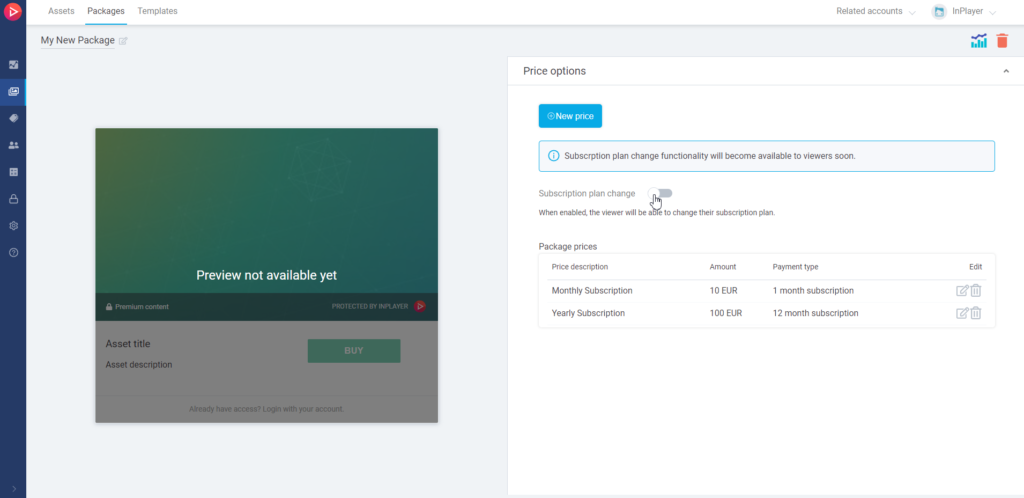
Enabling this will allow your viewers to upgrade or downgrade their subscription plan.
Upgrades on the viewer’s plan will happen and be billed immediately. A pro rata deduction for the unused portion of their old subscription will be applied to the charge for the new subscription.
Downgrades will happen and be billed after the expiration of their currently ongoing subscription cycle. Note that after choosing to downgrade, viewers cannot change plans while they’re waiting for the downgrade to happen. They can change their plan again once the downgrade has happened.
Note that upgrades/downgrades are only possible on payments made via credit card.
Viewers can upgrade or downgrade their subscriptions by following the instructions here.
Setting up a Season price
In the Price options section, click New price.
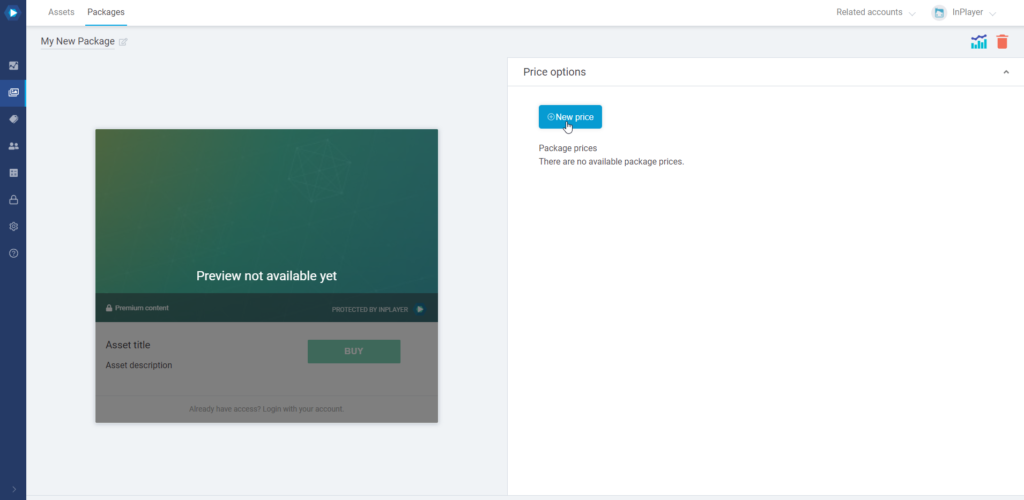
In the General info tab of the price option, set up the following:
- In the Price description field, enter the price description that will appear on the paywall. Make it concise so your viewers know exactly what they are buying.
- In the Payment type field, select season. With this payment type, the viewer purchases a season pass that lasts for a specific period, then expires, and is then renewed for a second period at a certain point in the future, upon which a new charge is taken from the viewer. The payment will continue to renew in the same manner for as long as you keep scheduling upcoming seasons.
The season payment type is best suited for seasonal content, like sports, where using standard back-to-back subscription payments might not be suitable, since content is only available during specific parts of the year, and in between there are periods with nothing or nothing new to watch.
A basic season cycle is represented here:
Setting up the first season phase
- In the Season start field, enter the start date and time of the season. This determines when the access for viewers who purchase a pass will start. It is also possible for access to be granted to the viewers from the moment of their purchase. This is accomplished with the Off-season access option. We’ll talk about that further below. Also, a season price option will not be available for purchase until the Season start has been set.
- In the Season end field, enter the end date and time of the season. This is the access cut-off date for the current season. Access will be re-granted upon the renewal of the payment for the next season. It is also possible for the access to continue beyond the end of the season, i.e. until the moment of renewal of the payment for the next season. This is, again, done with the Off-season access option, which we’ll see below. Also, a season price option will not be available for purchase until the Season end has been set.
- In the Next rebill date field, enter the date and time for the renewal of the payment, i.e. the date and time when the payment for next season will be taken. Note that once you set up the first rebill date, the rebill date for the next season will be automatically set to one year after the first date. You can always go back and change it if you wish.
- In the Next rebill price field, enter the amount that will be charged upon renewal for the next season, i.e. on the Next rebill date. Note that this is not the price for the current season.
The minimum price when using USD, EUR, or GBP is 1. When using all other currencies, the minimum is the equivalent converted amount of 1 USD.
The currency can be selected from the drop-down menu. If you wish to use a currency that is not in the list, you can contact us at clients@inplayer.com and we’ll make sure to add the currency for you asap. We support all currencies listed here. - In the Current price field, enter the account that will be charged for the current season. Whenever a viewer goes to your page, they will see this price. You can change this price at any time. For example, you can have it be equal to the New rebill price at the beginning of the season, and then reduce it as the season progresses.
The minimum price when using USD, EUR, or GBP is 1. When using all other currencies, the minimum is the equivalent converted amount of 1 USD.
The currency can be selected from the drop-down menu. If you wish to use a currency that is not in the list, you can contact us at clients@inplayer.com and we’ll make sure to add the currency for you asap. We support all currencies that are listed here. - With the Off-season access option, you can decide whether the viewers will only have access during a season (between the season start and end date), or also during the off-season period, so they can watch replays, for example.
Note that once you set the Season start, Season end, Next rebill date, and Next rebill price you cannot change them until the current season ends. You can only change the Current price amount.
In the Additional info tab, you can set up the following:
- Free trial
With this, you can set up a free trial period. If the Off-season access option is enabled, the free trial will begin right after the viewer completes their purchase. If the Off-season access option is disabled, the free trial will begin on the Season start date. - Additional fee
With this option, you can set up a one-time fee that will be charged when the viewer purchases the subscription, as an addition to the regular subscription fee. The fee will only be charged once, together with the first subscription charge. - Geo-restriction
With this option, you can restrict the price option to specific countries.
You can choose to either allow (whitelist) or deny (blacklist) a single country, or use a country set you have created previously.
You can learn more about setting up country sets here.
After setting everything up, make sure to click the Save button in the bottom right corner.
Setting up the next season phase (etc)
Click Add new phase.
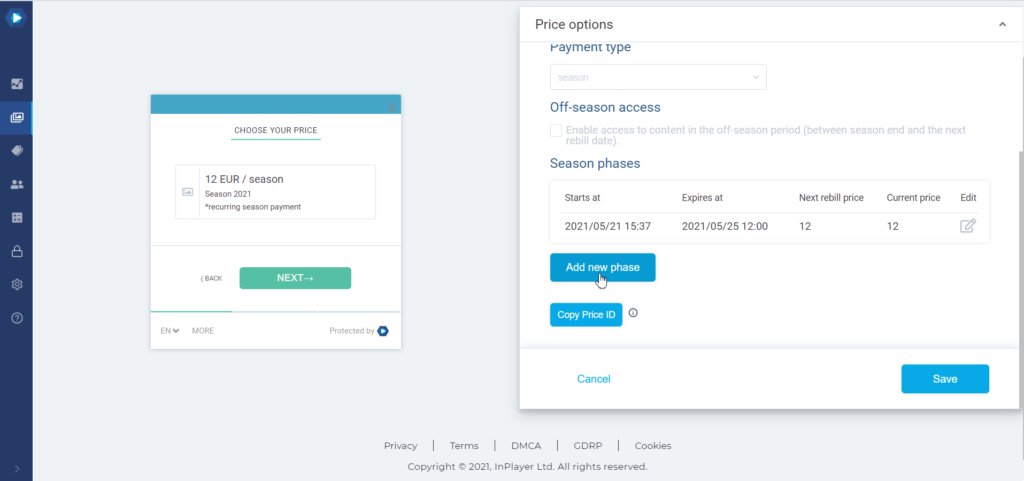
The same settings described above will be available, except this time you set them up from the next upcoming season.
Add a new phase for all future seasons.
Note that once you set the payment type for an asset, you cannot change it. You can change the other payment fields (access period duration, price, etc) but not the payment type. If you wish to set a new payment type, you will need to set up a new price option. You also cannot delete a season price option before the current season ends.
Deleting a price option
Deleting a price option from a package will make that price option unavailable for new purchases. Any viewers that have already purchased it will keep their access, and won’t be affected by this change.
To delete a price option, simply click the bin icon to the right of it.

Manage assets
Here you can add the assets you wish to include in the package. You can add as many assets as you want.
To add an asset, just drag and drop it from the left to the right side.
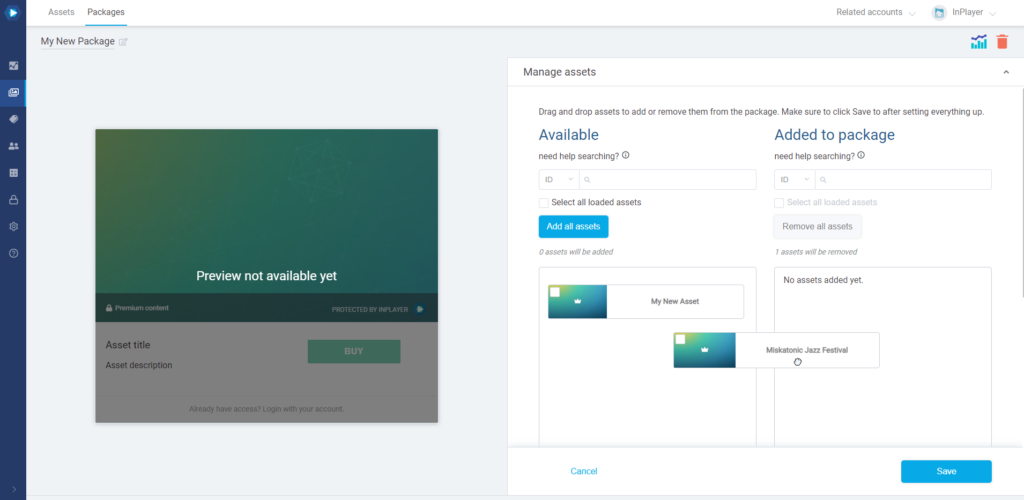
If you wish to add multiple assets at once just tick their checkboxes and drag and drop them to the right. You can also add all your assets at once by clicking Add all assets button, or add only the assets that are loaded in the list on the left by checking Select all loaded assets and then drag and dropping them to the left. Note that this only selects the assets currently loaded in the list on the left, and not all available assets.
Finally, click Save.
With that, the selected assets will be added to the package.
Additional metadata
Here, you can add additional metadata to your asset, which can be used for various purposes.

Deactivating a Package
To deactivate a package, just open it and click the ![]() button at the top right.
button at the top right.

You can always bring a deactivated package back by going to the Packages tab, selecting deactivated from the drop-down menu next to the search field, and just clicking on the package you wish to reactivate.
When you go back to the active packages list, you will find the package there.
This concludes our guide.
If you have any questions, don’t hesitate to contact us at clients@inplayer.com.
